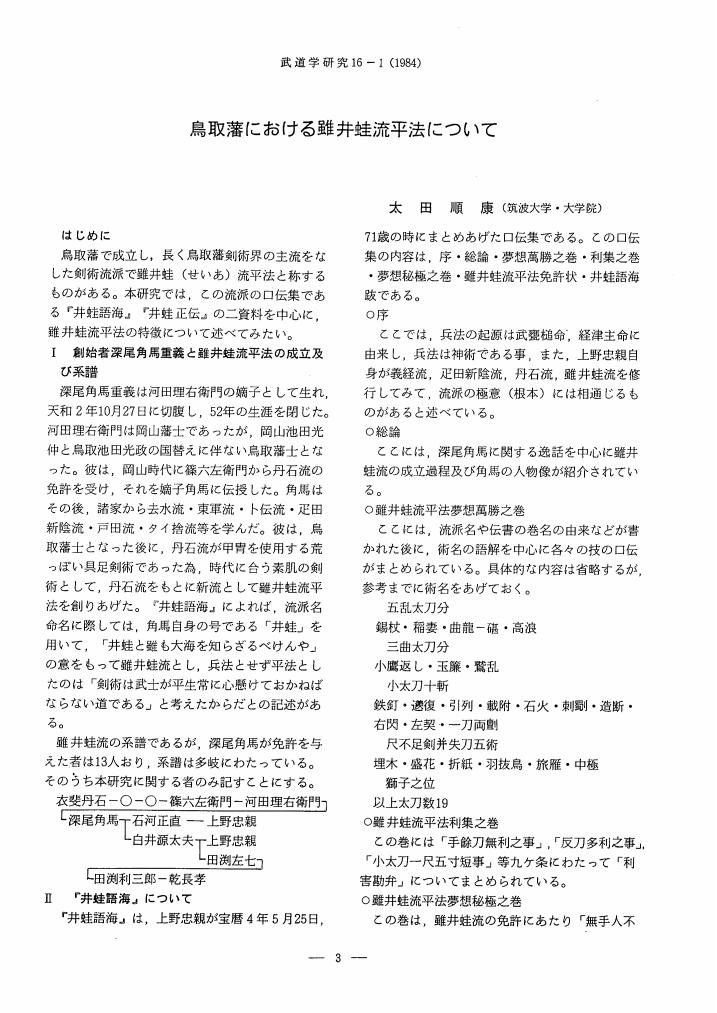10 0 0 0 IR フィンランドにおける健康施策とスポーツ実践の実態について
- 著者
- 松尾 邦枝 太田 順康 千住 真智子
- 出版者
- 大阪教育大学
- 雑誌
- 大阪教育大学紀要. 第4部門, 教育科学 = Memoirs of Osaka Kyoiku University (ISSN:03893472)
- 巻号頁・発行日
- vol.64, no.1, pp.69-80, 2015-09
本研究では,2014年2月21日~3月13日の日程で,ヘルシンキにおいてフィンランドのスポーツ振興の実態を調査し,福祉先進国と呼ばれているフィンランドの健康の取り組みについて明らかにするとともに,運動しやすい環境の整備状況について調査を行うことで,日本人の運動習慣の向上や健康づくりに関する知見を得ることを目的とした。フィンランドは,定期的にスポーツを実施している者(週1回以上)が国民の91%と世界一の生涯スポーツ先進国である(山口:2007)。フィンランドは,かつて欧米同様に生活習慣病が増大していたが,医療費削減のためにスポーツ促進を掲げた福祉向上政策を行った結果,スポーツ振興や施設の改良や拡大がおこなわれ,自国の歴史の中で培われた気質のあとおしもありスポーツが浸透し,スポーツ実施率は世界一となった。現在,スポーツ実施率が47.5%(2012年度)といわれている日本も今後,利用しやすい総合型地域スポーツクラブの拡大や,ウォーキング等を実施しやすい道路,公園の整備,体育館の利用方法の簡素化等の対策を進めることで運動・スポーツのさらなる促進につながると考えられる。This is a survey on the sports situation in Finland from 21st February to 13th March in 2014. The first purpose of this research is to learn the health policy of Finland, known as a country with one of the most highly advanced welfare systems. The second is to give some implication to the improvement of the exercise habits of the Japanese by learning the maintenance of the Finnish sports environment. Finland is also one of the lifelong sports countries over 90% of the population of which are regularly doing a certain sport, at least once a week (Yamaguchi 2007). In Finland, life-related disease used to be as popular as it is in America, but some welfare improvement implements were put into practice for the purpose of a reduction of its national medical expense. It brought a sport promotion and an expansion and improvement of facilities, backed up mutually by its own historical and cultural background. Thus sports habits spread throughout people and now Finland has the largest number of people doing sports. In Japan the ratio is still estimated to be around 47.5% (in 2012), but in the near future there will be an improvement of exercise and sports situation with more easy-accessible general sport clubs, maintained walking roads and parks, and with more simple procedure to use public facilities.
3 0 0 0 OA 武道史史料として絵葉書がもつ可能性について
- 著者
- 太田 順康
- 出版者
- 日本武道学会
- 雑誌
- 武道学研究 (ISSN:02879700)
- 巻号頁・発行日
- vol.51, no.Supplement, pp.S_18, 2018 (Released:2019-09-04)
2 0 0 0 OA 鳥取藩における雖井蛙流平法について
- 著者
- 太田 順康
- 出版者
- 日本武道学会
- 雑誌
- 武道学研究 (ISSN:02879700)
- 巻号頁・発行日
- vol.16, no.1, pp.3-4, 1984-01-31 (Released:2012-11-27)
- 参考文献数
- 4
1 0 0 0 IR 明治神宮体育大会に関する研究 : 明治神宮体育大会と昭和初期のスポーツについて
- 著者
- 太田 順康 長瀬 聡子
- 出版者
- 大阪教育大学
- 雑誌
- 大阪教育大学紀要. IV, 教育科学 (ISSN:03893472)
- 巻号頁・発行日
- vol.51, no.2, pp.485-499, 2003-02-28
本研究は, 大正13年にはじまり昭和18年に幕を閉じた明治神宮体育大会の大会開催の経緯及び発展経過を見ていくことで, 戦前の我国唯一の総合体育大会が開催されたことの意味を考える。この大会は, 内務省が企画し主催するが, 大正15年からは民間団体の明治神宮体育会が主催運営する。我国の軍国化に併せるように昭和14年からは厚生省が主導権を執る。この主催者の違いにより大会の性格や内容も異なる。その変化を年次毎に拡大していく参加種目数や選手宣誓に着目していく。政治色の濃い明治神宮体育大会ではあるが, 大会のもつ政治的意図は抜いて考えた時, 大会の存在は, 戦前のスポーツ界の組織化や競技化に大きな影響を及ぼした。また選手宣誓からは時代の特色が読み取れ, 世相をみる一つの尺度になることが明らかになった。The Meiji-jingu athletic meet is the first general athletic meet in Japan. The purposes were respecting Emperor Meiji and training mind-and-body of people. The Meiji-jingu athletic meet was held by three organizations. The first (1924-1925) was Interior, The second (1926-1937) was the Meiji-jingu gymnastics, and The third (1939-1943) was Welfare. The Meiji-jingu athletic meet cannot be made light of the sport history, because it contributed to the progress in sport. However, there is little detained precedence research. Then, we clarify based on the report in the Osaka Kyoiku university library. It is worthy to have held this athletic meet. In addition, the athletic meet affected systematization of a sport. Transition and a player oath in this athletic meet express the social trend. We discovered becoming one scale that looks at the early stages of Showa.
- 著者
- 太田 順康 鎌倉 洋志
- 出版者
- 大阪教育大学
- 雑誌
- 大阪教育大学紀要 第4部門 教育科学 (ISSN:03893472)
- 巻号頁・発行日
- vol.57, no.1, pp.55-75, 2008-09
日本の伝統的身体運動文化である剣道は,世界に広がり2006年12月に台北で第12回世界剣道選手権大会(以下,WKC)が44ヵ国・地域(以下,地域を略す)参加のもと盛大に開催された。剣道の近代化と剣道の大衆化に試合・大会の果した役割は大きく,剣道普及を考える上で,試合・大会の在り方は重要なものである。そこで世界剣道選手権大会と第22回を迎えるヨーロッパ剣道大会(以下EKC)の二つの大会を比較し,これからの剣道の国際普及を考える手がかりを得ること目的とした。剣道の試合には,チャンピオンシップとしての競技的側面,フレンドシップとしての親善・親睦的側面などがある。この両立は困難なもので,国々に参加する意識に違いがあれば,それぞれを目指した性格の異なる世界大会の開催する必要もあるということも視野に入れていくこともありえよう。今後,この両大会の推移を見つめながら,剣道の国際的普及・国際化を論じていく必要があると考える。Kendo is Japanese traditional body movement culture. Kendo spread in the world, and 12th WKC (World kendo championship) was opened in Taipei in 2006. The role which the game played in modernization of kendo and popularization of kendo is important. A game is indispensable to kendo spread. Then, this paper compared two games, the WKC (World kendo championship) and the EKC (Europe kendo championship), and purpose of this paper is considering the international spread of kendo. There are the championship-side, and goodwill and the friendship-side in the game of kendo. Coexistence of championship and a friendship is difficult. Then, opening of two world games from which character differs is also needed. It is necessary to discuss international spread and internationalization of kendo, gazing at transition of both this game.
1 0 0 0 IR 大学競技スポーツ組織の現状と今後の展望: アメリカNCAAに焦点を当てて
- 著者
- 井上 功一 入口 豊 太田 順康 吉田 雅行
- 出版者
- 大阪教育大学
- 雑誌
- 大阪教育大学紀要. IV, 教育科学 (ISSN:03893472)
- 巻号頁・発行日
- vol.50, no.1, pp.193-210, 2001-08
本研究では,高度に発展しているアメリカ大学競技スポーツを統括する組織の1つ,アメリカ最大の組織NCAAに焦点をあてて,アメリカ大学競技スポーツ組織のメリット,デメリットを考察し,そこから得られた知見から我が国の大学競技スポーツ組織の今後の展望を図ることを目的とした。本研究において,我が国の大学競技スポーツ組織の問題点として,個別に学生連盟組織が存在していることや,大学の教職員が連盟の役員などを兼任していることなどが上げられた。また,NCAAにおいては統括組織や,専任の職員が多数いること等がメリットとして挙げられる反面,巨額の資金を抱えるなどの問題点も挙がった。今後,我が国の大学競技スポーツは組織の統一,専任の職員,女性スポーツへの援助,諸問題への対応という点においてNCAAを参考に改革を進めていかなくてはならない。The purpose of this study was to make the organization of NCAA (National Collegiate Athletic Association) in the U.S.A. and Japanese collegiate athletics' current status clear and to examine the future prospects of Japanese collegiate athletics. The finding and discussions on the following topics are presented in this paper: 1. The current status and problems of collegiate athletic organization in Japan (1) The current status of collegiate athletic organization in Japan (2) The problems of collegiate athletic organization in Japan 2. The currernt status of collegiate athletic organization in the U.S.A. (1) The NCAA in the American Collegiate athletics (2) About the NCAA (3) Purpose of the NCAA (4) Colleges and Universities of Participating to the NCAA and sports (5) History of the NCAA (6) Existence of Athletic Department (AD) (7) Example of AD (UCLA) 3. Merit of the NCAA (1) Organizations of unification (2) Full-time staffs (3) Process of unification 4. Demerit of the NCAA (1) Financial problem (2) Amateurism (3) Schoolwork of students' athlete (4) Gamble 5. The future prospect of collegiate athletic organization in Japan (1) Unification of the organizations (2) Employment of the full-time staffs (3) Support to collegiate women's sports (4) Possibilities of some problems
- 著者
- 太田 順康 千住 真智子 吉田 雅行
- 出版者
- 大阪教育大学
- 雑誌
- 大阪教育大学紀要 4 教育科学 (ISSN:03893472)
- 巻号頁・発行日
- vol.42, no.2, pp.p305-315, 1994-02

